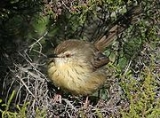
Drakensberg Prinia
Encyclopedia
The Drakensberg Prinia or Saffron-breasted Prinia, Prinia hypoxantha, is a small passerine
bird
. This prinia
is an endemic resident breeder South Africa
.
It is a species of forest edges wooded gullies and bracken
covered slopes in the Drakensberg
. The Drakensberg Prinia was formerly considered to be a subspecies
P. m. hypoxantha of the Karoo Prinia
, P. maculosa.
and the upperparts are otherwise brown. The throat and lower face are whitish with no streaking and the rest of the underparts are yellowish with dark streaking. The long tail has a dark spot near the end and is typically cocked up at an angle. The feet and legs are pinkish-brown, and the eye is pale.
The sexes are identical, but juveniles are paler below than the adults.
The calls of this species include a sharp chleet-chleet-chleet-chleet-chleet-chleet, and a fast buzzy tit-tit-tit-tit-tit
The Drakensberg Prinia can only be confused with the closely related Karoo Prinia, but that species has less yellow underparts with heavier spotting.
The Drakensberg Prinia is usually seen in pairs or small groups, typically low in scrub, but sometimes perching on the top of a bush. It actively forages for small insect
s, with tail cocked and frequently swung side-to-side.
Passerine
A passerine is a bird of the order Passeriformes, which includes more than half of all bird species. Sometimes known as perching birds or, less accurately, as songbirds, the passerines form one of the most diverse terrestrial vertebrate orders: with over 5,000 identified species, it has roughly...
bird
Bird
Birds are feathered, winged, bipedal, endothermic , egg-laying, vertebrate animals. Around 10,000 living species and 188 families makes them the most speciose class of tetrapod vertebrates. They inhabit ecosystems across the globe, from the Arctic to the Antarctic. Extant birds range in size from...
. This prinia
Prinia
The prinias are a genus of small insectivorous birds belonging to the passerine bird family Cisticolidae. They are often also alternatively classed in the Old World warbler family, Sylviidae. The name of the genus is derived from the Javanese prinya, the local name for the Bar-winged Prinia.The...
is an endemic resident breeder South Africa
South Africa
The Republic of South Africa is a country in southern Africa. Located at the southern tip of Africa, it is divided into nine provinces, with of coastline on the Atlantic and Indian oceans...
.
It is a species of forest edges wooded gullies and bracken
Bracken
Bracken are several species of large, coarse ferns of the genus Pteridium. Ferns are vascular plants that have alternating generations, large plants that produce spores and small plants that produce sex cells . Brackens are in the family Dennstaedtiaceae, which are noted for their large, highly...
covered slopes in the Drakensberg
Drakensberg
The Drakensberg is the highest mountain range in Southern Africa, rising to in height. In Zulu, it is referred to as uKhahlamba , and in Sesotho as Maluti...
. The Drakensberg Prinia was formerly considered to be a subspecies
Subspecies
Subspecies in biological classification, is either a taxonomic rank subordinate to species, ora taxonomic unit in that rank . A subspecies cannot be recognized in isolation: a species will either be recognized as having no subspecies at all or two or more, never just one...
P. m. hypoxantha of the Karoo Prinia
Karoo Prinia
The Karoo Prinia or Spotted Prinia, Prinia maculosa, is a small passerine bird. This prinia is a southern African endemic resident breeder in Namibia, South Africa, Lesotho, and Swaziland....
, P. maculosa.
Description
The Drakensberg Prinia is 12-14 cm long, with short rounded wings, a longish tail, strong legs and a short straight black bill. The head has a whitish eyebrowSupercilium
The supercilium is a plumage feature found on the heads of some bird species. It is a stripe which runs from the base of the bird's beak above its eye, finishing somewhere towards the rear of the bird's head. Also known as an "eyebrow", it is distinct from the eyestripe, which is a line which runs...
and the upperparts are otherwise brown. The throat and lower face are whitish with no streaking and the rest of the underparts are yellowish with dark streaking. The long tail has a dark spot near the end and is typically cocked up at an angle. The feet and legs are pinkish-brown, and the eye is pale.
The sexes are identical, but juveniles are paler below than the adults.
The calls of this species include a sharp chleet-chleet-chleet-chleet-chleet-chleet, and a fast buzzy tit-tit-tit-tit-tit
The Drakensberg Prinia can only be confused with the closely related Karoo Prinia, but that species has less yellow underparts with heavier spotting.
Behaviour
The Drakensberg Prinia builds a thin-walled oval nest with a side entrance from green grass. It is well hidden deep inside a leafy shrub or bush.The Drakensberg Prinia is usually seen in pairs or small groups, typically low in scrub, but sometimes perching on the top of a bush. It actively forages for small insect
Insect
Insects are a class of living creatures within the arthropods that have a chitinous exoskeleton, a three-part body , three pairs of jointed legs, compound eyes, and two antennae...
s, with tail cocked and frequently swung side-to-side.

